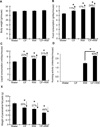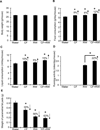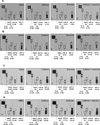Oral caffeine during voluntary exercise markedly inhibits skin carcinogenesis and decreases inflammatory cytokines in UVB-treated mice
- PMID: 24070239
- PMCID: PMC3830615
- DOI: 10.1080/01635581.2013.812224
Oral caffeine during voluntary exercise markedly inhibits skin carcinogenesis and decreases inflammatory cytokines in UVB-treated mice
Abstract
Ultraviolet B (UVB)-pretreated SKH-1 mice were treated with water, caffeine (0.1 mg/ml), voluntary running wheel exercise (RW) or caffeine together with RW for 14 wk. Treatment of the mice with caffeine, RW, or caffeine plus RW decreased skin tumors per mouse by 27%, 35%, and 62%, respectively, and the tumor volume per mouse was decreased by 61%, 70%, and 85%, respectively. In mechanistic studies, mice were treated with water, caffeine, RW, or caffeine plus RW for 2 wk prior to a single irradiation with UVB. Caffeine plus RW increased RW activity by 22% when compared with RW alone. Caffeine ingestion was not significantly different between groups. Treatment of mice with caffeine plus RW for 2 wk decreased the weight of the parametrial fat pads and stimulated the formation of UVB-induced apoptosis to a greater extent than treatment with caffeine or RW alone. An antibody array revealed that caffeine plus RW administered to mice fed a high-fat diet and irradiated with UVB decreased the epidermal levels of lipopolysaccharide-induced CXC chemokine, soluble TNF alpha receptor-1, and macrophage inflammatory protein-1γ. Overall, caffeine during RW exerts a stronger effect than either treatment alone for decreasing tissue fat, increasing UVB-induced apoptosis, lowering the levels of cytokines associated with inflammation and for inhibiting UVB-induced carcinogenesis.
Figures






Similar articles
-
Inhibition of UVB-induced nonmelanoma skin cancer: a path from tea to caffeine to exercise to decreased tissue fat.Top Curr Chem. 2013;329:61-72. doi: 10.1007/128_2012_336. Top Curr Chem. 2013. PMID: 22752580 Free PMC article.
-
Voluntary exercise together with oral caffeine markedly stimulates UVB light-induced apoptosis and decreases tissue fat in SKH-1 mice.Proc Natl Acad Sci U S A. 2007 Jul 31;104(31):12936-41. doi: 10.1073/pnas.0705839104. Epub 2007 Jul 30. Proc Natl Acad Sci U S A. 2007. PMID: 17664435 Free PMC article.
-
Inhibitory effects of voluntary running wheel exercise on UVB-induced skin carcinogenesis in SKH-1 mice.Carcinogenesis. 2006 Oct;27(10):2108-15. doi: 10.1093/carcin/bgl057. Epub 2006 May 13. Carcinogenesis. 2006. PMID: 16699173
-
Effect of caffeine on UVB-induced carcinogenesis, apoptosis, and the elimination of UVB-induced patches of p53 mutant epidermal cells in SKH-1 mice.Photochem Photobiol. 2008 Mar-Apr;84(2):330-8. doi: 10.1111/j.1751-1097.2007.00263.x. Epub 2008 Jan 7. Photochem Photobiol. 2008. PMID: 18179623 Review.
-
Stimulatory effect of oral administration of tea, coffee or caffeine on UVB-induced apoptosis in the epidermis of SKH-1 mice.Toxicol Appl Pharmacol. 2007 Nov 1;224(3):209-13. doi: 10.1016/j.taap.2006.11.001. Epub 2006 Nov 7. Toxicol Appl Pharmacol. 2007. PMID: 17188726 Review.
Cited by
-
Pseudomonas aeruginosa infection augments inflammation through miR-301b repression of c-Myb-mediated immune activation and infiltration.Nat Microbiol. 2016 Aug 8;1(10):16132. doi: 10.1038/nmicrobiol.2016.132. Nat Microbiol. 2016. PMID: 27670114 Free PMC article.
-
Coffee consumption and the risk of malignant melanoma in the Norwegian Women and Cancer (NOWAC) Study.BMC Cancer. 2016 Jul 29;16:562. doi: 10.1186/s12885-016-2586-5. BMC Cancer. 2016. PMID: 27473841 Free PMC article.
-
Caffeine intake may modulate inflammation markers in trained rats.Nutrients. 2014 Apr 21;6(4):1678-90. doi: 10.3390/nu6041678. Nutrients. 2014. PMID: 24763113 Free PMC article.
-
Mechanisms of Photoaging and Cutaneous Photocarcinogenesis, and Photoprotective Strategies with Phytochemicals.Antioxidants (Basel). 2015 Mar 26;4(2):248-68. doi: 10.3390/antiox4020248. Antioxidants (Basel). 2015. PMID: 26783703 Free PMC article. Review.
-
Caffeine Mitigates Lung Inflammation Induced by Ischemia-Reperfusion of Lower Limbs in Rats.Mediators Inflamm. 2015;2015:361638. doi: 10.1155/2015/361638. Epub 2015 Nov 16. Mediators Inflamm. 2015. PMID: 26648663 Free PMC article.
References
-
- Lu Y-P, Lou L-R, Lin Y, Shih WJ, Huang M-T, et al. Inhibitory effects of orally administered green tea, black tea, and caffeine on skin carcinogenesis in mice previously treated with ultraviolet B light (high-risk mice): relationship to decreased tissue fat. Cancer Research. 2001;61:5002–5009. - PubMed
-
- Lu YP, Lou YR, Li XH, Xie JG, Brash D, et al. Stimulatory effect of oral administration of green tea or caffeine on ultraviolet light-induced increases in epidermal wild-type p53, p21(WAF1/CIP1), and apoptotic sunburn cells in SKH-1 mice. Cancer Research. 2000;60:4785–4791. - PubMed
-
- Michna L, Lu YP, Lou YR, Wagner GC, Conney AH. Stimulatory effect of oral administration of green tea and caffeine on locomotor activity in SKH-1 mice. Life Sciences. 2003;73:1383–1392. - PubMed
-
- Lou YR, Lu YP, Xie JG, Huang MT, Conney AH. Effects of oral administration of tea, decaffeinated tea, and caffeine on the formation and growth of tumors in high-risk SKH-1 mice previously treated with ultraviolet B light. Nutrition and Cancer. 1999;33:146–153. - PubMed
-
- Michna L, Wagner GC, Lou YR, Xie JG, Peng QY, et al. Inhibitory effects of voluntary running wheel exercise on UVB-induced skin carcinogenesis in SKH-1 mice. Carcinogenesis. 2006;27:2108–2115. - PubMed
Publication types
MeSH terms
Substances
Grants and funding
LinkOut - more resources
Full Text Sources
Other Literature Sources
Medical
